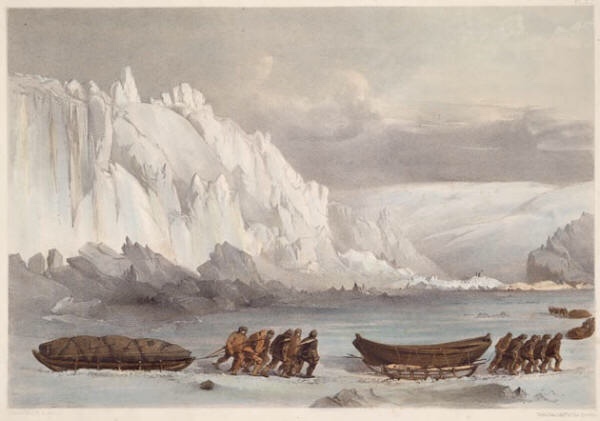

Well, this was an ace read, no mistake! I was glued to it from start to finish. Palin has, as we all know, a very engaging character. And he writes as well, better even, perhaps, than he presents TV travel adventures.
In this very easy to read and rather compelling book he tells the story of the ship Erebus, a ‘bomb ship’ converted for polar exploration, that has a fascinating story, full of life and death. For the sake of ease and simplicity, we can call the life part the Ross expedition, and the death part the Franklin expedition.
Built in the wake of the Napoleonic wars, it’s military or naval purpose condemned Erebus to the doldrums of instant obsolescence, initially. Until she was realised to be, along with the equally scarily named (slightly older and slightly smaller) Terror, perfectly suited to adaptation for work in the polar extremes.
Designed and built to be quite small but very strong, so as to carry heavy mortars (the ‘bombs’), she needed less fiddling with to be made ready for the freezing conditions of polar exploration than most ships.

Palin tells her tale, from her birth at Pembroke in Wales, to her re-fitting(s), and her periods of idleness at Chatham, right the way through to when the ‘nearly ship’ of the British Navy became one of the most famed.
As well as the story of the boat, there’s also the interwoven strands of broader history. After Napoleon’s defeat, Britain’s maritime pre-eminence helped these tiny islands punch well above their weight internationally, helping found a massive global empire.
And this empire was growing apace as much for reasons of a more enlightened kind, as for those more normal reasons of imperialistic avarice; ever more wealth and power. Erebus would find fame not for her martial prowess, but for furthering knowledge and science, as well as national and commercial interests. Oh, and for both triumph and tragedy.
And so it is that the 19th C. enquiry into global geo-magnetism assumes an important place in these tales. This is a golden Age of Enlightenment influenced rational science. The era of Darwin and the rise of ‘natural history’. And representing that we have several characters, chief of whom is Joseph Hooker, aged just 22, travelling on Erebus, under the care of the dashing Captain, James Ross.

Having already followed Erebus’ career, from manufacture to patrolling the Med, and then into Ordinary (semi-retirement!), the biggest chunk of the book is concerned with an epic four year voyage to the Antarctic, under Ross. It’s terrifically evocative and gripping stuff!
After the triumphant return of this initial expedition, it’s successes – which were by no means complete – soon lead to another attempt at finding the fabled ‘Northwest Passage’. But this time the crew on Erebus, under Capt. JohnFranklin, would be almost entirely different, as would their fate.
Intriguingly several characters we have already met in the Erebus’ former wanderings – such as Franklin and Crozier – come into the foreground in this ‘second act’ of polar adventure. And it is their misfortunes that we follow next.
Palin does a great job of telling this story in a way that maintains one’s interest, because, at the crucial moment in the doomed second voyage, all goes eerily quiet. Franklin, who we first meet in Tasmania, and is now Captain of Erebus, and all aboard both Erebus and Terror, simply vanish. No news is forthcoming.

As anxieties mount back home, officials dither. This is partly understandable, as polar explorers were known to get frozen in over winter. But the degree of tardiness in the face of growing certainty that something was wrong is pretty shocking.
The story then switches from that of the boat and her crew to that of those searching for her/them. And here things are slow and patchy in developing. Once again Palin unfolds this in a masterful manner, maintaining one’s interest where it might, like the attempts to locate the lost explorers, have simply petered out.
And thus it is that the Erebus’ story brings us up to very near the present day, as she is eventually located, in 2014.
Our voyages of exploration, unlike Ross’, Franklin’s, and even Palin’s (he journeys in the footsteps – or should I say wake? – of these heroic explorers) may be from the cosy comfort of our homes. But Palin takes us, through words and pictures, on an amazing journey, to the very ends of the earth.

And this fantastic story takes in not just heroism and the awful sublime grandeur of nature, at her most powerfully disinterested in us mere mortals, but runs the gamut of feelings, from intoxicated wonder (and plain old intoxication; these are rum-soaked sailors, after all) and elation, to illness, death, and horror.
Beautifully written, on a fascinating subject; well illustrated, with maps, old paintings and prints, and plentiful photos (ranging from daguerreotypes of crews, to kelp festooned wreckage), this really is a fantastic book!
* This is the only written document covering the death throes of the Franklin expedition to have survived and come down to us.

PS – I love model ships, and have a few books – one or two rather lovely! – on the subject. I once even tried my hand at building a wooden one, as a child. It was an awful balsa-wood failure (trashed by my sister!), inspired by the three Unicorns of Tintin/Haddock fame. I still hanker after building some nice old ‘age of sail’ type models. Erebus seems like an appealing subject. Hmmmm!?
Also worthy of note, it appears Ridley Scott has made a film or TV series about the expedition, named after the other boat of the expedition, The Terror!

